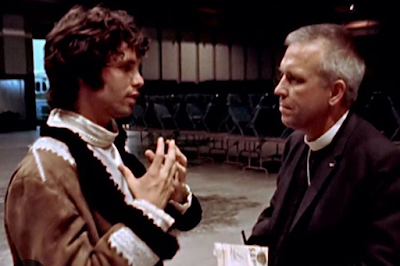THE DOORS’ “WISHFUL SINFUL”: AN ORCHESTRAL EXPERIMENT
Soon after the release of The Doors' third LP, “Waiting for the Sun” (July 1968), the long and grueling recording process for their next album, “The Soft Parade” (released a year after, in July 1969), began.
Among the first songs recorded in the summer of 1968 was “Wishful Sinful”,
written by the band's guitarist, Robby Krieger.
The tune followed the stylistic groove established by his recent
composition "Yes, The River Knows". Anyway, the song was chosen to
experiment with a new arrangement approach that would later be repeated on other
tracks.
Krieger and The Doors' producer, Paul Rothchild, opted for orchestral
accompaniment, taking inspiration from hugely successful records such as The
Beatles' Revolver and Sgt. Pepper's Lonely Hearts Club Band.
The orchestra, which had a strong influence on the overall sound,
consisted of a combination of strings and horns. It was recorded in November
1968, around four months after the July session in which the drums, electric
bass and electric guitar were laid down.
The orchestration greatly enhances the romantic atmosphere of the tune.
However, it shifts the composition from rock to pop-rock, lacking the
originality required to sustain this transition unharmed.
The questionable decision to replace Ray Manzarek's keyboards with a
melancholy, floating blanket of strings and horns is detrimental to the
composition as a whole.
This unsatisfactory result is symbolized by the brief English horn solo
(from min. 1:28 to min. 1:39), arguably one of the least enjoyable moments in
The Doors' entire discography.
A fairly common trend in 1968–69, the addition of cumbersome orchestral
backgrounds detracted from the quality of many otherwise fine works of the
period. Examples include the first two Nick Drake LPs and Judy Sill's first album.
The rhythm section, consisting of drums and electric bass, plays a
passionate role in adding dynamics and depth to the progression of the
melodies.
In particular, the bass line stands out for its imaginative yet fluid
pulse. It was conceived and played by Doug Lubahn, an excellent session
musician known for his praiseworthy work on two earlier LPs by The Doors,
"Strange Days" and "Waiting for the Sun".
Of course, Morrison's vocals contribute to enhance the appeal of
"Wishful Sinful".
The singer's performance is notable in the short bridges that connect
the verses and choruses (listen from min. 0:22 to min. 0:34, for example), especially
when he sings the line "Right back where I came".
The rhythm breaks here, taking on a rock-like appearance for a few
seconds and enabling the temporary emergence of the scratchy energy that only
Morrison's vocals can express.
In 'Wishful Sinful', the singer exhibits his peculiar 'Frank
Sinatra-esque' style, which fits well with the pop-tinged melodies and is
constantly supported by the slightly distorted arpeggio of the electric guitar.
Over time, a version of “Wishful Sinful” that predates the orchestral
overdubbing has also been made available.
It is surely worth a listen (link here), but it cannot be considered satisfactory due to a structural problem.
The recording was actually made with the intention of adding horns and
strings to the arrangement at a later date.
Consequently, empty spaces were deliberately left in the recording,
which makes this stripped-down track more of a demo than an alternative version
of the original song.
“Wishful Sinful” was released as a single in March 1969 (its B-side was “Who
Scared You”), four months ahead of its appearance on the album “The Soft Parade”.
It reached the 44th spot in the US without entering the UK charts.
P.S.: My book "The Doors Through Strange Days"- The most comprehensive journey ever made through The Doors' second LP, is out and available on Amazon.com, .uk, .mx, .it, etc.
Here’s a link:




Comments
Post a Comment